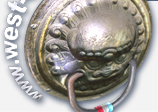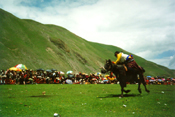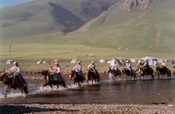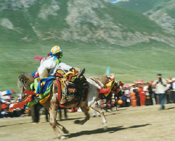| Two Great Tibetan
Khampa Horse Race Festivals in East-Tibet
1. 17th July
Arrive at Beijing in the morning. In the afternoon take CA1221 14:40PM/16:40PM
Beijing/ Lanzhou, a capital city of Gansu Province, an important
industry city in Northwest China (Alt:1600m) and the vital communication
line of the old Silk Road. Nothing interesting to see inside the
city except the Provincial Museum. We can visit it in the afternoon,
if time allows. Lanzhou Sunshine hotel, 3 star.
2. 18th July
Drive 290km (7 hours) to Labrang (Alt:2900m). On the way, 2/3 first
part of the road we pass the Chinese Muslim Hui people area with
many Mosques along the roadsides. Lunch is in Linxia Hui Autonomous
City, which is horned as “Small Hong Kong” by local people
as you can buy anything you want in this Moslem city. There is one
street specially selling Tibetan antiques and souvenirs, which is
worth seeing for half an hour as the prices may cheaper than Labrang.
At last part of the road wherever you see the white Chortans which
will make you felling you are in Tibetan area and landscape is much
more beautiful. Overseas hotel or other good hotels with facility
and hot water for shower.
3. 19th July
In the morning we visit Labrang monastery built in 1709, now it
has 1000 monks. It is one of the six important Gelukpa (the Yellow
Sect) monasteries in whole Tibet and a center of Tibetan learning
in Eastern Tibet. We can find many Tibetan nomads who come here
for pilgrimage and to buy textiles for their clothing and jewellery
along numerous Tibetan shops.
4. 20th July
After breakfast, we drive 130km about 4 hours to Repkong (Alt:2400m).
On the way, we pass grassland, forestry, agricultural land and beautiful
Red Mountain valley. Hua Nan hotel with facility and hot water for
shower.
In the afernoon, we visit the famous Tibetan art school, Sengeshong
Magotsang which was funded during the 15th century and after 16th
century Repkong became the home town of Tibetan art in Amdo. All
monks here have good training of painting and sculptures and are
often invited to make fine art works in many monasteries or private
houses by Tibetan in whole Tibet even nowadays. We will visit some
of monks’ houses.
5. 21st July
In the morning we visit the Longwu (Tib: Rongpo Gonchen ) Monastery,
an important and the local biggest monastery, built in 1301. At
beginning it was Sakyapa monastery, after 17th century, the 5th
Daly Lama changed it into Gelukpa and once was the political and
administration center in Repkong area. Now it has 450 monks. In
the afternoon we visit Gomar monastery built in 1741 and now it
has 160 monks inhabited. This small but beautiful monastery is famous
for its colorful 7-storey Astronomy (Tib: Dhekor; Sanskrit: Kalachakra)
stupa, mainly used for monks to realize and understand time and
space to work out every year’s new Tibetan calendar and relationship
between our globe with universe. The monks and the village people
are also renowned for their handcraft application.
6. 22nd July
Drive 360km (8hours) to Machen (Tib:) County (Alt: 3700m). During
the driving, the scenery is fantastic changeable by passing forestry,
mountains, grassland, nomads tents and then reach to the Yellow
River bank where you see large land of rape seeds yellow flowers.
Government guest house, no hot water for shower.
7. 23rd July
Drive 260km ( 6hours) to Mato (Chin: Madoi)County (Alt: 4200m).
Mato means the place where the Yellow River starts originally and
through here to central Tibet had been considered as one of the
important roads for centuries. Government Guest house or Traffic
Hotel, both hotel is the local best but sometime no hot water for
shower.
8. 24th July
Drive 360km to Jyekundo (Chin. Yushu) County, alt: 3700m. Today’s
driving is exiting; we pass the first bridge of the Yellow River,
the famous mountain pass Bayankala at elevation 5080m and upper
reaches of the Yangtse River. Those landscapes present you an amazing
picture: Under the blue sky with white clouds, you see different
type of mountains decorated with pray flags, beautiful grassland
embellished with flock of yak and sheep, nomad’s black and
white tents, the colorful dressed Golok and Khampa people while
some different sects of old monasteries on the way without tourists
to visit, which brings you back to the nature. Stay in Yushu hotel
with facilities in the rooms and hot water for shower.
9.-11. 25th/27th July
The local people honoured Jyekundo as small Lhasa and more than
90% of people here is Tibetan Khampa people, one of the four Tibetan
main tribes. They are strong and wild but honest and former fierce
warriors of Tibet. Many Sakyapa monasteries are concentrated here
with different construction style. Today a big Tibetan Festival
take place on grassland. All will be dressed in colorful costumes,
wearing their best jewelry and ornaments. There will be horseracing,
dancing and archery tournament, all by the nomadic people. This
goes on for three days.
12. 28th July
Drive 350km to Manigango, a very small and simple town as most of
Tibetan houses are built with timber. Many nomadic families come
here for shopping and to taste different food in this town which
brings you a strong feeling of old post. On the way we pass Sershul
monastery and one of the three important Nyinmapa monasteries Dzogchen
Gompa, just 3km away from the main road and 53km to Manigango but
it is hidden in a beautiful valley. Stay in a simple but clean hotel
without facility.
13. 29th July
Drive 110km to Ganzi, was once the largest and most important town
in Kham area during the 17th century. Ganzi Gonpa is in town built
in 1642 by Mongols. We must visit the oldest temple Den Gonpa, a
very important protector monastery for the area.
Khampa hotel or other better hotels.
14. 30th July
Drive 300km to Xinduqiao (Tib:Dzongzhab) township, which is a transportation
hub for truck drivers overnight. Stay in the local best hotel but
no shower and facility.
15. 31st July
Drive 210km to Litang, which is honored as “Paradise on Earth”
by local Tibetan and the city was built on beautiful grassland at
altitude 4200m. Characterized by its large stone houses, people
here is very proud of the birth place of the Dalai Lama 3. and 7.We
visit Litang Chode, built by Dalai Lama 3 in 1580. Stay in Highland
Pearl Hotel.
16.-18. 1st 3rd August
Stay for three days here to see the Litang Horse Race Festival.
19. 4th August
Drive 355km to Damba, a place where the Tibetan Gyarong lives. They
are another tribe which is different from Golok and Khampa people.
They speak their dialect and maintained unique way of life with
their own culture for centuries. The dress is also distinctive.
Most of the women wear multi-colored embroidered headscarves and
elaborate belts and aprons. In old days almost every family has
its own block-house built with stones, ascending to heights of between
30-60 meters, which kept the powerful sino-Manchu armies at bay
for 10 years during 18th century. Damba Government Guest Hotel with
facility and shower.
20. 5th August
Trekking about one hour to visit Gyarong people’s village and
private houses in a valley along the tributary of Yangtze River.
21. 6th August
Drive 340km to Chengdu. Stay in Jinjiang Hotel 5 star.
22. 7th August
In the morning fly to Beijing.
23. 8th August
Transfer to International Airport and fly back to home.
|




